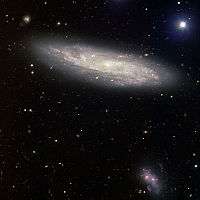NGC 2770
| NGC 2770 | |
|---|---|
|
NGC 2770 and companion galaxy Credit: Gemini Observatory/AURA. | |
| Observation data (J2000 epoch) | |
| Constellation | Lynx |
| Right ascension | 09h 09m 33.7s[1] |
| Declination | +33° 05′ 05″ |
| Redshift | 1941 ± 7 km / second |
| Distance | 88 Mly (27 Mpc)[2] |
| Apparent magnitude (V) | 12.0[1] |
| Characteristics | |
| Type | SAC(s)c[1] |
NGC 2770 is a type SASc spiral galaxy located about 88 million light years away, in the constellation Lynx.[1] Three Type Ib supernovae have occurred there recently: SN 1999eh, SN 2007uy, and SN 2008D.[3] The last of these is famous for being the first supernova detected by the X-Rays released very early on in its formation, rather than by the optical light emitted during the later stages, which allowed the first moments of the outburst to be observed. It is possible that NGC 2770's interactions with a suspected companion galaxy may have created the massive stars causing this activity.[4]
NGC 2770 was also the target for the first binocular image produced by the Large Binocular Telescope.[5]

The Type Ib supernova Supernova 2008D in galaxy NGC 2770, shown in X-ray (left) and visible light (right). NASA image
References
- 1 2 3 4 "NASA/IPAC Extragalactic Database". Results for NGC 2770. Retrieved 2008-05-26.
- ↑ Soderberg, Alicia; et al. (May 22, 2008). "An extremely luminous X-ray outburst at the birth of a supernova". Nature. 453 (7194): 469–474. arXiv:0802.1712
 . Bibcode:2008Natur.453..469S. doi:10.1038/nature06997. PMID 18497815.
. Bibcode:2008Natur.453..469S. doi:10.1038/nature06997. PMID 18497815. - ↑ Thoene, Christina C.; et al. "NGC 2770 - a supernova Ib factory?". arXiv:0807.0473
 .
. - ↑ "Catching the Light of a Baby Supernova". Gemini Observatory. Archived from the original on 7 July 2015. Retrieved 7 July 2015.
- ↑ LBT Press Release - First Binocular Light
External links
- Astronomers Witness Supernova's First Moments
- NASA Astronomy Picture of the Day: Supernova Factory NGC 2770 (18 January 2008)
- NGC 2770 on WikiSky: DSS2, SDSS, GALEX, IRAS, Hydrogen α, X-Ray, Astrophoto, Sky Map, Articles and images
Coordinates: ![]() 09h 09m 33.7s, +33° 05′ 05″
09h 09m 33.7s, +33° 05′ 05″
This article is issued from Wikipedia - version of the 9/26/2016. The text is available under the Creative Commons Attribution/Share Alike but additional terms may apply for the media files.
